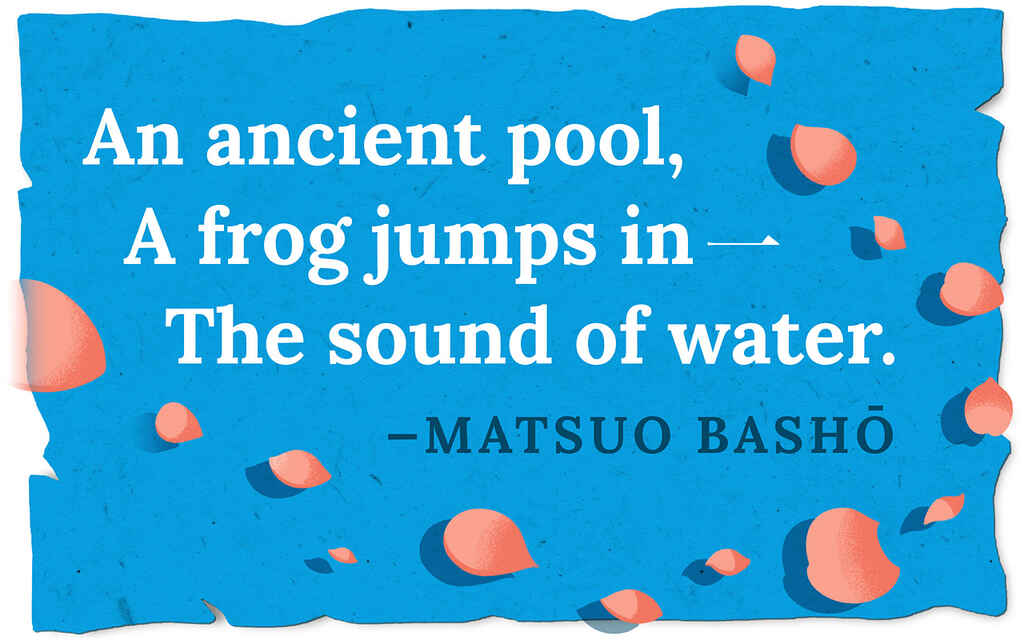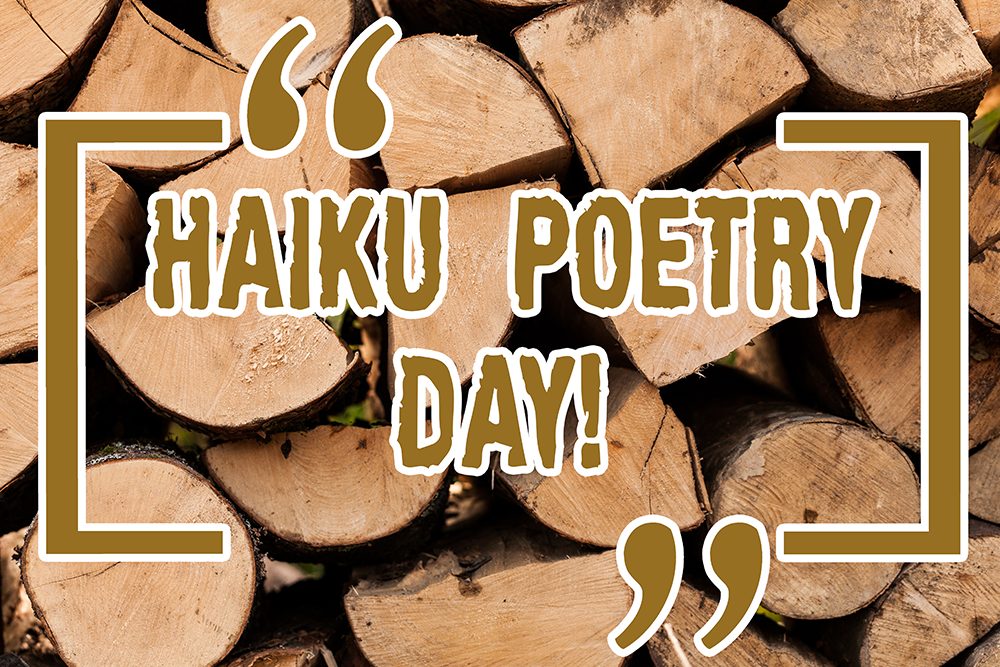
Free download Haiku in English Poetry Season Japan, japan, winter
Japan's Beloved Poetry haiku Definition & Format Explained. Japanese traditional poetry known as haiku has three lines. It usually has 17 syllables, which are placed in a 5-7-5 rhythm. There are a certain number of syllables in each line, with the first line having five, the second having seven, and the third having five once again.

HAIKU The traditional Japanese haiku consists of three lines. The
Haiku is a traditional form of Japanese poetry that has captivated readers and writers around the world with its simplicity and depth. Originally known as "hokku," haiku emerged as a distinct poetic form in the 17th century, with roots in the collaborative linked-verse poetry called "renga." Haiku focuses on the essence of a moment or.

Suku Kata Dalam Puisi Jepang Haiku KT Puisi
The format of Japanese. 5-7-5 syllables ( 17 syllables in all) Must use a seasonally word (phrase), " kigo " (read below). The strucure of haiku is basically 5-7-5, 15 syllables. It is a poem that place value on the rhythm of sound, so it is better to keep 5-7-5 as possible. It is like a samba rhythm for Brazilians.

Mengenal Haiku, Puisi Pendek dari Jepang Redaksiana
Salah satu karya seni di Jepang adalah puisi haiku, jenis puisi pendek yang terkenal dari masa lalu. Berbeda dengan puisi biasa, jenis puisi pendek ini hanya mengikuti kerangka-kerangka lama dengan tiga barisnya. Ada banyak hal lebih dari itu terutama pada bagian suku kata yang digunakan di setiap barisnya.

Haiku for Japan
shōfū Top Questions haiku, unrhymed poetic form consisting of 17 syllables arranged in three lines of 5, 7, and 5 syllables respectively. The haiku first emerged in Japanese literature during the 17th century, as a terse reaction to elaborate poetic traditions, though it did not become known by the name haiku until the 19th century.

What is a Haiku? Japan’s Beloved Poetry Format, Explained (2022)
Before the haiku, the main form for Japanese poetry since ancient times was the waka in its short version of 5-7-5-7-7. If two writers collaborated,.

Mengenal Haiku Sebuah Puisi Tradisional Jepang
Despite its succinct form, it contains the essence of Japanese people's aesthetics, view of nature, philosophy, thought, and sentiments. As a rule, haiku must have a kigo (a word connoting a season) and are rendered in three lines of 5, 7, and 5 syllables each. The kigo is a reflection of the Japanese people's sensitivity to the changing.

Haiku by Shiki Haiku poems, Basic japanese words, Very short poems
Haiku adalah puisi tiga bait asal Jepang yang memiliki struktur berupa 5-7-5 suku kata. Selain memiliki aturan 5-7-5 suku kata, haiku juga mewajibkan dalam penggunaan kigo dan kireji yang berarti "kata yang melambangkan musim atau alam" serta "kata penghubung atau pemotong".

Haiku Puisi Khas Jepang Rumah Bahasa Jepang / Kursus Bahasa Jepang
Interestingly, traditional haiku are more correctly known as hokku, which can be traced to their historic and stylistic origin. Classical Japanese poetry is known as waka and has been composed in patterns of 5 and 7 syllables since the 6th century. Most classical poetry followed form known as tanka, composed of 5 lines, with a structure of 5, 7.

Japanese Haiku Poem by Matsuo Basho showing the fragility of life
Traditional Japanese haiku consist of three phrases composed of 17 phonetic units (called in Japanese, which are similar to syllables) in a 5, 7, 5 pattern; [1], or "cutting word"; [2], or seasonal reference. Similar poems that do not adhere to these rules are generally classified as [3]

Haiku by Basho Japanese Poem, Japanese Haiku, Japanese Quotes, Very
Haiku (俳句 ) adalah sejenis puisi Jepang, revisi akhir abad ke-19 oleh Masaoka Shiki dari jenis puisi hokku (発句 ) yang lebih tua. Hokku tradisional terdiri dari 5, 7, dan 5 morae . Penulis terkenal Periode Pra-Shiki (hokku) Matsuo Basho ( 1644 - 1694) Onitsura ( 1661 - 1738) Yosa Buson ( 1716 - 1783) Kobayashi Issa ( 1763 - 1827)

Japanese Haiku GiaknoeLozano
Haiku is a traditional form of Japanese poetry in which you create short simple poems following a very basic structure. Unlike, say, a limerick, the goal of a Haiku is not necessarily to be clever or funny though many modern examples are both. Haiku does not even need to rhyme. They are usually used to evoke a sense of imagery or feeling, to.

Haiku . tradisional Jepang
Jepang sendiri mempunyai bentuk puisi dalam format 5-7-5 yang disebut haiku. Meskipun haiku biasanya merupakan ungkapan kisah kehidupan sehari-hari, tetapi ada beberapa yang merupakan puisi cinta. Baik itu penantian, kerinduan, hingga kata-kata dan situasi yang mengingatkan kita akan cinta dan kekasih.

Haiku Tips dan trik menulis puisi khas Jepang J Study
This was a haiku 俳句 はいく, a short Japanese poem that presents the world objectively and contrasts two different images. While Bashō wasn't the first to write haiku, this poem became the model that all haiku would be compared against and defined the form as we know it today. But a haiku is more than just a poem that follows the skeleton of Old Pond.

The Art of Japanese Haiku Poetry
The Origins of Japanese Haiku. Haiku as a tradition dates back to ancient Japan. It's fore-bearer, renku, was a sort of combination parlor game and performance art—part poetry reading, part rap battle. In it, poets would take turns improvising humorous (and, to be honest, often filthy) verses that built on each other's themes and styles.

Mengenal Haiku Sebuah Puisi Tradisional Jepang ARTFORIA
Posted on May 12, 2022 What is a Haiku? Japan's Beloved Poetry Format, Explained A haiku is a traditional Japanese poem that captures emotional responses evoked by nature. The most common haiku format is a three-line poem with a 5-7-5 syllable structure and no rhyme requirements.